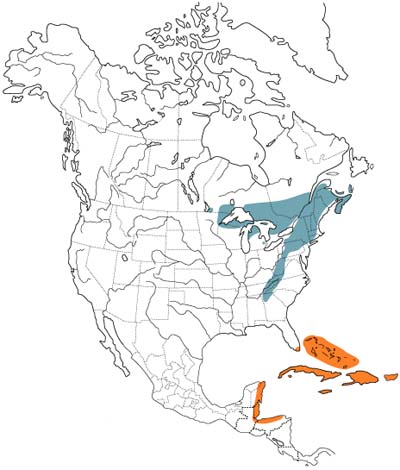| Study
Species
| |

Map of the breeding
(blue) and wintering (orange) ranges of the Black-throated
Blue Warbler (from the Birds of North America Species
Account).
|
To learn more about how the environment
affects the reproductive success of migratory birds, researchers
have been studying Black-throated Blue Warblers (Dendroica
caerulescens) breeding at the Hubbard Brook Experimental
Forest in New Hampshire. These birds are long-distance migrants,
splitting the year between breeding grounds in the U.S. and
Canada and wintering grounds in and around the Caribbean. Each
spring, they fly north to breed in the forests of the northeastern
U.S. and southeastern Canada and along higher elevation areas
in the Appalachian Mountains. Across their breeding range they
favor deciduous and mixed deciduous-coniferous forests, where
they build their nests in the shrubby understory.
These warblers are an excellent
species to study because it is fairly easy to watch their behavior,
find their nests, and monitor their breeding success. Also,
their populations are not declining (luckily, this species tolerates
some logging and other disturbances in its breeding and wintering
habitat). Yet the factors that affect the reproductive success
of Black-throated Blue Warblers are likely to apply to many
other species whose populations are smaller and harder to observe.
In fact, research on this species has already taught scientists
a lot about how populations are limited and regulated, and how
migratory birds might respond to climate change.
|